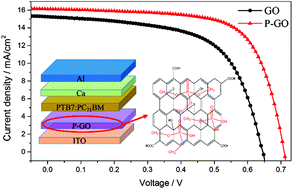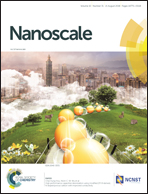Noncovalent phosphorylation of graphene oxide with improved hole transport in high-efficiency polymer solar cells†
Abstract
Graphene oxide (GO) has been extensively applied as an alternative hole transport layer (HTL) of bulk heterojunction polymer solar cells (BHJ-PSCs) with the function of selectively transporting holes and blocking electrons, but suffers from low electrical conductivity. Herein, using phosphorus pentoxide (P2O5) dissolved in methanol as a precursor, we successfully modified GO via noncovalent phosphorylation for the first time, which showed improved hole transport in BHJ-PSCs compared to the pristine GO. As a result, BHJ-PSC devices based on noncovalently phosphorylated GO (P-GO) HTL show dramatically higher power conversion efficiencies (7.90%, 6.59%, 3.85% for PTB7:PC71BM, PBDTTT-C:PC71BM, P3HT:PC61BM, respectively) than those of the corresponding control devices based on the pristine GO HTL (6.28%, 5.07%, 2.78%), which are comparable to those of devices based on the most widely used HTL—poly(3,4-ethylenedioxythiophene):poly(styrenesulfonate) (PEDOT:PSS).



 Please wait while we load your content...
Please wait while we load your content...